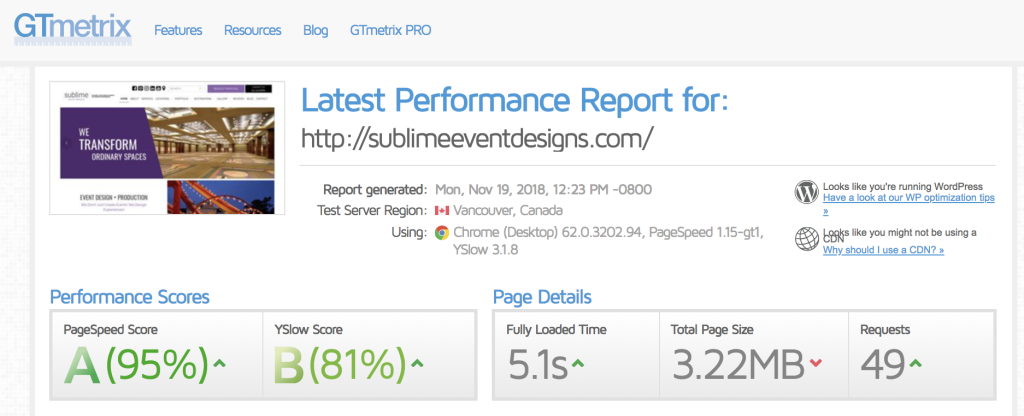What makes a good website?
People often ask us to explain what makes a good website. Whether we have a list of elements that a great site should have. Unfortunately, there isn’t an easy, one-size-fits-all answer to this. As in many things SEO, the answer is: it depends. What kind of site do you have and what do you want to achieve? Who do you want to target? There are, however, a few best practices that help you get underway. In this post, we’ll list 7 elements that can help every site become a good site and a better search result.
7 elements of a good website
Many things we deem important for a good website are hard to quantify. There’s a lot of talk about quality in SEO, for instance. Even Google has been saying for years that you should focus on the quality of your site and content. After every algorithmic update that Google implements, the answer for those who lost rankings is the same: it might not be your fault, because other sites might seem to be a better fit for this specific query. Nonetheless, you should work on the overall quality of your content.
People flock to the Search Quality Raters Guidelines for input on how to do that, looking for any guidance at all. Now, you shouldn’t take everything that Google says as gospel, but in this case, they are right. You should improve your content — always! Make sure to look at user intent and the behavior of your potential customers. Periodically redo your keyword research. And check your niche, what’s happening in your part of the market? By continually evaluating your SEO strategy, you’ll get a grip on the changing market and find new opportunities.
1. Your website satisfies user intent and has a clear goal
Do you know your audience? Do you know your business and what it is you contribute to this world? Why should anyone come to your site and do business with you? It’s not because you think you have an awesome product — that just doesn’t fly anymore. “Build it and they will come?” Unfortunately, that’s not how it works. You need to have a clear mission and goal for your website.
If you want to succeed, you need to know your audience. You have to uncover everything about them. You can probably find out what they say they want, but is that the same as what they really need? Does your product or service merely offer a possible solution to a problem or does it make your customer’s life genuinely better? Are you selling a drill or a hole in the wall?
Your story has to be right. It has to align with what people want and need. This means you should nail search intent for your site. Uncover all the different ways of how people can end up on your pages and tailor these to answer their questions. Map out your user journey from A to Z and place your content in strategic spots. Also keep a close eye on the way you formulate your answers. More often than not, a conversational style will turn out to be what you are looking for.
2. Your website has technical prowess
A good website is easily crawlable and shows search engines what they can and can’t index. Good sites don’t have a huge amount of errors. A good website loads super fast, from anywhere in the world. Make sure you do everything you can to get those pages to load as fast as possible.
Technical SEO is incredibly important, but you can get ahead of the curve by getting the basics right. Thoroughly think about which CMS you’re going for and how you’re going to run it. We may be a bit biased, but WordPress has given us everything we need. It’s solid, flexible and has a huge following. WordPress is pretty SEO-friendly, but with a bit of help from Multimedia Graphics you can get your WordPress SEO going in no time. Also make sure to pick a reputable hosting company, one that’s flexible and helpful.
3. Your website is trustworthy, safe and secure
Both search engines and users are looking for signals that signify trust. Why should your site and content be trusted? Things like regular downtime might be an indication of sloppy maintenance. A missing green lock icon can mean you don’t take security seriously. There are a lot of hints that they look for.
Search engines like Google want to give searchers the best possible result. Increasingly, if a search engine doubts the claims you make or if you use sketchy ‘experts’ to validate your content, they will not show your content. Instead, they will pick a result that has proven to be a good and trustworthy result. That’s why you need to work on your trustworthiness on all levels, both technical as well as in content.
In addition, your site should be a safe haven for visitors. You need to have your security in order. A hacked site isn’t getting you anywhere! And a hacked site is easier to prevent than it is to fix. Use up-to-date software, have your SSL in order, create strong passwords and use tools such as Cloudflare to protect your site from DDoS attacks.
4. Your website has a great design and stellar UX
Does your website need to be beautiful? Let’s be honest, beauty is in the eye of the beholder. The design of your website needs to help fulfill the goals you set. Your message should come across loud and clear. The design should be on-brand and well-thought-out. But more importantly, your site should be clear and easy to use for everyone. Accessibility is not something you should scrimp on.
You also need to consider user experience. Which is not only how something looks, but also how it feels. It’s about giving users an enjoyable experience, something they will remember. UX is also not letting users wait long for your pages to load, getting them frustrated because they can’t read the text on your site thanks to your color scheme or because they can’t hit the buttons on your mobile site. Think to yourself: how can I turn any possible frustration on my website into happiness?
And happy users might just have higher buyer intent, so get those CTAs in order!
5. Your site has awesome, user-centered content
Be user-centered, not company-centered. Good content helps your users accomplish their goals and you want to offer this content at the right moment while keeping the business goals firmly in sight. To do so, you need to know your user inside out, as I mentioned earlier. Understand them, understand their behavior and focus your content on that. The content you offer should be clear and easy to understand by using language your users know well. Try to bring something unique to the table. Do the research and present original reporting.
6. Your site is mobile-friendly (or rather, designed mobile-first)
For the last couple of years, mobile traffic has kept growing and growing. If your site is not mobile-friendly by now, you should really get to it and work on your mobile SEO. But if your site has been mobile-friendly for a while, it is time to start looking at building your next site mobile-first.
It’s not a new concept, but most sites are still being developed desktop-first. After designing the desktop view, the designer crams it down to mobile size, often losing its authenticity and freshness along the way. Adopting a mobile-first mindset helps you focus on the tasks users should be able to perform on your mobile site. It helps to clean up the clutter and, more often than not, lets you come up with a minimal and fully focused design. Less is more, remember?
7. Your site can ‘talk’ directly to search engines
For years, search engines tried to read content on pages to determine what that page is about. They need that content to be able to match the search query with the indexed pages that give the best answers to this query. Turns out that truly understanding what something on a page is or means, is harder than it seems, especially for machines. Search engines need a little guidance to discover the true meaning of elements on a page. Enter, structured data in Schema format.
Schema is kind of like a translator for search engines. It describes elements on a page, so search engines can now say with certainty that a review is a review and a recipe is a recipe. In return, because Google is so certain about the content, marking up these elements can lead to rich results in the search results pages. This includes carousels, nutritional information for recipes, star ratings, FAQ dropdowns, swipeable How-To boxes on mobile and much, much more. Structured data is one of the areas search engines spend a lot of resources on these days, so make sure to get on board.
We noticed this and built a complete and fully extendable Schema framework inside . This structured data implementation builds a complete graph for your site, so search engines not only know what everything means but also how everything is connected to the bigger picture. In addition, SEO comes with a few structured data blocks and we’re working on adding more in the future.

1. Organization and Structure:
Good websites are well organized and follow a structure. They are not cluttered; they are clean and professional. They are also built around a target audience and market. Organization makes a website accessible and user-friendly.
By creating a thoughtful organizational structure in your website, site visitors will be able to better navigate and find the content in your site. Furthermore, a clear organization and structure allows Google to easily crawl and index your website.
2. SIMPLE NAVIGATION:
Successful websites offer simple and user friendly navigation. Visitors must find everything they need quick and easy. If users have to wonder around the site trying to find what they need they will get frustrated and leave. Thus, it is important to include an intuitive navigation bar on your website.
Depending on the size of your website and the amount of
content, you might consider implementing a mega menus, also known as
uber menus. These type of menus go beyond the typical drop-down menus by
allowing you to organize content in your navigation bar using columns.
3. ORIGINAL CONTENT:
High quality websites focus on their audience’s needs, not on what they’re selling. Good and fresh content builds the visitor’s interest and invite them to get involved, invite their friends and come back for more.Furthermore, Google values content that is relevant and interesting for users, so creating original content is a great way of double dipping when it comes to making a good website. Some companies decide to do this by writing articles or blog posts about their products or events, while others create pages addressing frequently questions asked by customers(FAQ’s).
4. OUTSTANDING DESIGN:
Beautiful & contemporary design makes a site memorable. A good website is built around a theme that matches its market and personality. However, outstanding design also encompasses a business’ brand and takes into account the user’s experience. Hence, it is highly important to design a website for both desktop and mobile devices. Lastly, good websites are designed for all audiences, from those with colorblind conditions to user’s with more serious disabilities.
5. SPEED:
Users don’t want to wait for slow content to download; they need their information quickly and without delay. In today’s internet spaces, most users know that if they click on a website and it does not load as fast as they expect, they can go back and click on another one that will deliver quickly. Optimized graphics, video and audio give a website the necessary speed it needs to load fast.
On the other hand, when it comes to decreasing page speed time for mobile, Accelerated Mobile Pages (AMP) comes in handy. This is a project backed by Google to quickly load websites on mobile devices. All in all, page speed plays a major factor when it comes to staying ahead of your competitors. If you want to learn more about website’s speed, check out the following articles:
6. CLEAN AND VALIDATED CODE:
Messy, outdated, deprecated, or wrong code can reduce a website’s search engine visibility. In fact, when marketers and web designers analyze your website to see what can be improved, they will most likely look at your website’s code first.
Furthermore, It can also generate browser-rendering issues that will slow down your website. Validated code will help for browser compatibility; following the standards is a way to ensure that the site will have a higher chance to be correctly display in different browsers. There are many HTML validators available online that can help you examine and improve your code. Lastly, clean code can save you time as well since it is easier to troubleshoot.
7. EASY TO READ:
Most people don’t read websites; they scan them. Contrast and hierarchy help the site’s readability by making the content easy on the visitor’s eyes. Contrast between the text color and the website background is very important. Good websites will never use a black background color and dark blue text or white background color and yellow text.
Hierarchy helps people identify important sections on the website. High-quality websites use headings to break up the content in sections and provide small blocks of text to help their visitors read their content better.

8. SEARCH ENGINE OPTIMIZATION:
A great website with no visitors is an invisible website. SEO or search engine optimization will help bring an audience to the site. It is also important to consider that bringing relevant users plays a key role in the growth of a website. It is not just about establishing a generic audience, it is about bringing potential customers that will appreciate and pay for your services.
Efficient SEO takes time and effort to see results, but it will strengthen your site and deliver ROI (return on investment). This is usually accomplished by implementing strategies such as: creating advertising campaigns, optimizing and promoting quality content frequently, backlinking, conducting keyword research to determine what your audience is looking for and even examining and cleaning up code. Does this sound overwhelming? Check out more of our SEO resources below to better understand how it can help your website and business:
9. Tracking:
Metrics & site analysis give insights of what’s going on in a website. Good sites measure their traffic and marketing efficacy. Tracking also helps to target better a site’s customers, generate relevant ads, and create a higher converting website.
After all, one of the biggest advantages of today’s analytics tools is that it allows marketers to pinpoint where exactly your customers are completing an action or not. These actions can be completing an online purchase, filling out a form or subscribing to your newsletter. In order to have a good website, it is essential to frequently track what’s working and what’s not to make educated improvements. If you would like to learn more about tracking and web analytics, make sure to stop by our Orlando Internet Marketing page.
10. Link building
Links are an important factor in determining where a website will appear in search engine results. Good websites promote themselves in other high-quality websites like Google Local, Yahoo! Local, Yellow Pages, LinkedIn and more. Another way to promote and improve link building is to submit articles to websites related to your industry. Most online magazines or blogs allow a link back to your website from your article.
Think about link building as the word-to-mouth referral process of the cyber universe. If leading websites in your industry have links to your website, that is valuable traffic and prospective clients that are you are receiving purely through links outside of your site. A good example of how link building works is reflected in industry specific review pages (such as Homeadvisor.com for home repairs) which will guide visitors to the services provided in your website through links. Do you still have doubts about link building? Explore the articles below and multiply your website’s traffic today.



No comments:
Post a Comment